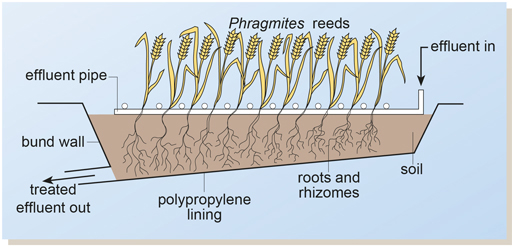6.4.2 Reed beds
Reed beds, or artificially constructed wetlands with emergent plants, have been used to treat sewage in many parts of the world. In Ethiopia, studies have been carried out on this type of wastewater treatment system for domestic wastewaters in Addis Ababa (Genet, 2007) and Kombolcha (Sahu and Yimer, 2014), and brewery effluent in Addis Ababa (Angassa, 2011).
Reed beds are ideal for warm countries where plants grow rapidly. They have low operational costs but they do require a lot of land.
The plants (usually reed species Phragmites australis or Phragmites communis) are grown in rows in beds of soil or gravel lined with an impermeable clay or synthetic liner (Figure 6.11). The effluent requiring treatment is fed into the bed, which typically has a depth of 600 mm. The base of the reed bed has a slope to enable collection of the effluent after treatment.

The effluent is distributed through pipes and nozzles onto the reed bed and then percolates down to the roots and rhizomes (horizontal underground stems) of the reeds. The root and rhizome system provides a mix of aerobic and anaerobic conditions that encourage a diversity of microbial species in the soil. As a result, the reed bed system has potential for treating a wide range of pollutants. For example, although micro-organisms that are capable of biodegrading many synthetic chemicals (such as some common pesticides) are found in soil, they not normally present in effluent treatment plants, so reed beds can be effective for treating effluents that contain these types of chemicals.
Can you think of an additional advantage that reed beds offer?
Reed beds are very attractive to birds and thus increase the diversity of wildlife where they are constructed.
6.4.1 Waste stabilisation ponds
